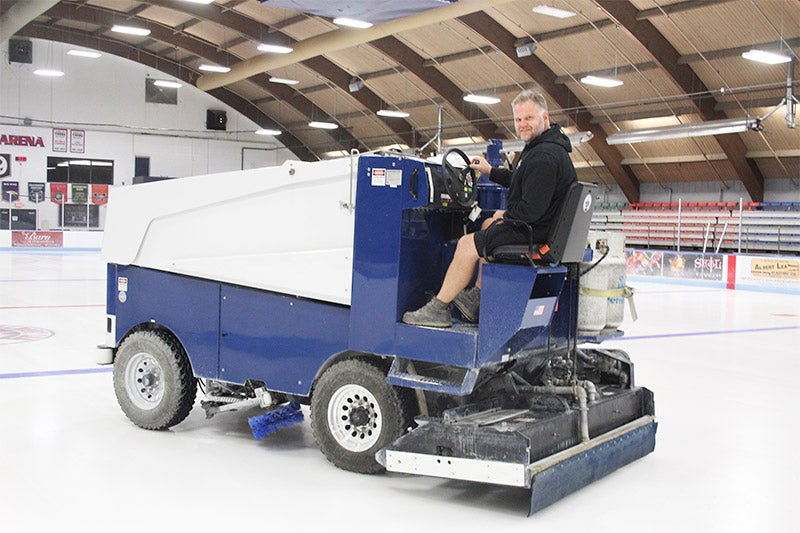The science behind indoor ice rinks
Published 5:53 pm Thursday, August 31, 2023

- One of Josh Heilman's responsibilities include performing ice maintanence with a Zamboni. Alex Guerrero/Albert Lea Tribune
|
Getting your Trinity Audio player ready...
|
Even with temperatures ranging from the 50s to the 90s, Albert Lea City Arena has ice laid down.
Josh Heilman, the city’s ice arena/aquatic center foreman, knows all about ice, especially the differences between indoor and outdoor ice.
“An indoor rink is going to be an enclosed environment where it’s going to be heated and cooled, versus an outside rink, which is just basically whatever the weather is,” he said. “We’re able to make the climate toward where it needs to be in the off-season of winter.”
According to Heilman, making an indoor rink was not the same as building an outdoor one either. To build a rink, ambient temperatures need to remain between 50 and 60 inside the building, humidity at 40%, a dew point of 35% and the concrete slab floor needs to be at 16° for Heilman to make ice. Compressor temperatures need to be between 14° and 20°.
That will keep ice temperatures at roughly 22°.
“We start up the system, we’ve got four compressors that we run a Glycol system off of in our Nystrom Arena,” he said, adding they started the system roughly a week ahead of the icing process. That’s so Heilman and his team can begin the installation process.
The first step in making an indoor rink was getting floor temperatures down to 16° with the compressor and cooling system, with the compressor system set to between 10° and 14°.
“It [16°] is just a good setup point for the water to set up,” he said.
He’ll then go out with a spray boom, where he’ll spray 1/16-1/8 of an inch of water onto the rink to create ice. Once there is a base coat of clear water, he’ll put a gray base coat down with the spray boom and paint the ice gray, which will serve as the underlayment of the final coat and serves to take out any blotchiness the concrete may show, including different patterns in paint.
After that’s on, he will clear-coat that with clear water using a water sprayer before using three 50-pound boxes of white paint and apply it at three separate times to build a white base, which he said was the playing field for a hockey rink.
Heilman then clear coats the white before painting lines and logos.
He’ll also use a Zamboni for 8 to 10 minutes between skating sessions.
“After usage [ice] gets chopped up, a lot of snow out on there, so it goes out and cleans up, fills up all the holes and lays a flat water surface for a fresh coat,” he said.
In total, Heilman estimated it took two weeks to get an indoor rink ready from start to being able to use.
Maintaining an indoor rink was also different.
“We’re looking for basically a solid structure [of] ice all the time, we can’t control the climate outside,” he said. “Going back to the indoor rink we can control the climate for an indoor rink, which makes it able for us to have the ice year-round.”
He’ll also go out with a drill to conduct ice measurements and use an ice edger around the outside of the skating boards.
“That brings my floor depth down to where I want it, and then I go back out with a Zamboni and cut down to where the edger cut down to,” he said.
During the busy season — September to March — he’ll use the edger daily.
“Otherwise if we keep putting ice on it without taking off a certain amount of ice, we’re just going to have a big heave of ice out there, and we need to keep our level anywhere from an inch to 1 1/2 of ice,” he said.
Nystrom rink at City Arena was installed in late August and will be removed in March following a figure skating show.
“We take it out just for energy savings, and also we hold dry floor events through the summer,” he said. “We hold Quinceañeras, weddings, dog shows.”
Colstrup, the city’s practice rink, keeps ice until the Fourth of July. Preparations for turning it into a rink will begin in mid-September.
As for why the back rink was opened longer, Heilman explained there were issues with that rink, and they’re looking at putting a new rink floor and system in.
“What happens is the floor raises up 2 inches over the winter cause of moisture and water underneath it,” he said. “By turning off the system, that lets the system settle and brings the floor back.”
Colstrup also implements a geothermal system.
“It’s based off a heat and cold system, and that also runs off Glycol,” he said.
For Heilman, the biggest challenges in maintaining an indoor rink included maintaining a climate and ensuring compressor systems were working.
Heilman has been maintaining ice in City Arena since 2016.
“I played hockey as I grew up, so I had interest in hockey and I just had a love for the arena,” he said.
Roughly 35,000 people visit the city arena annually.





